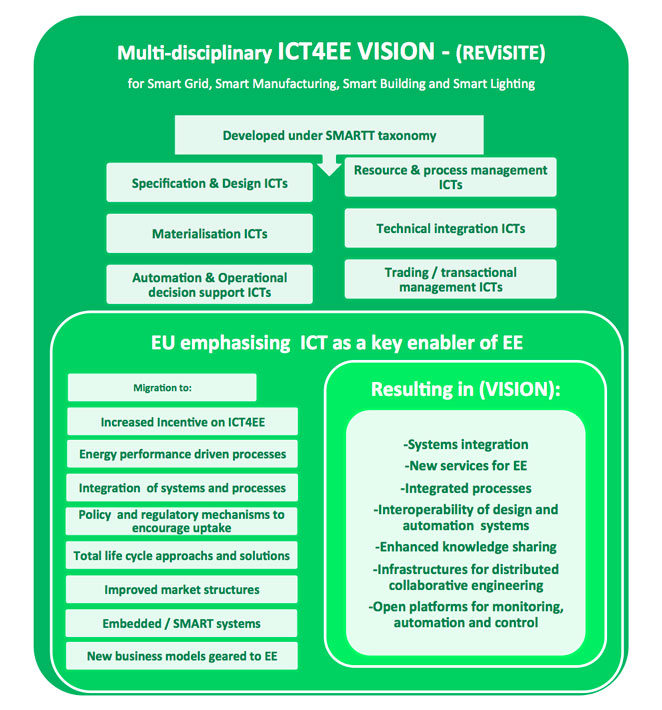Vision
The REViSITE vision is aimed for more transparency in identifying ICTs that can positively impact on energy efficiency, by categorising where ICT adoption and development should be focused, based on anticipated level of impact.

The value of the cross sectoral approach to the sectors is based on the premise of abstracting sector specific issue to a more general issue, identify possible general ICT solutions, and then focus on adopting or adapting as a sector specific solution. The SMARTT Taxonomy was used to categorise ICTs, aligning them to a generalised life cycle that is recognisable to specific sectors. ICTs need to focus on: Specification & design, Materialisation, Automation & operation support, Resource & process management, Technical integration and Trading and transactional management. REViSITE can more clearly identify ‘what’ ICTs should be adopted or developed, 'where' they should be applied and ‘how’ they are likely to impact on sustainability. These ICTs are foreseen to contribute to the realisation of the vision where:
- New services for EE are widely available
- Processes and systems are integrated
- Design and automation systems are interoperable with the availability of cross sectoral data exchange standards
- Knowledge sharing related to energy consumption and grids loads is enhanced and facilitated
- Infrastructures for distributed collaborative engineering are available
- Open platforms for monitoring, automation and control are widely used
- Embedded / SMART systems are in operation
- New business models geared to EE are implemented with a shift from 'consumer culture' to 'prosumer culture'
The summary sheet of the vision report is available here.
The main report on the vision is available here.
The technical report on Vision for Multi-disciplinary ICT-enabled Energy Efficiency is available here.
Our choice from the blog ...
REViSITE Workshop on “ICT for Energy Efficiency: Cross–sectoral Interoperability”
Read more ...
REViSITE releases its initial Strategic Research Agenda (SRA)
Read more ...
REViSITE launches online questionnaire on its Strategic Research Agenda
Read more ...
REViSITE and Commission Workshops at the CIB W78 Conference in Sophia Antipolos, October 2011
Read more ...
REViSITE Blogs ...
REViSITE ITU ‘Green Standard Week’
Read more ...




